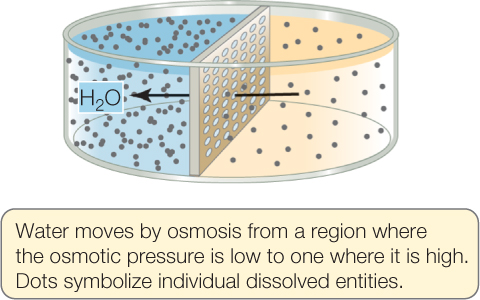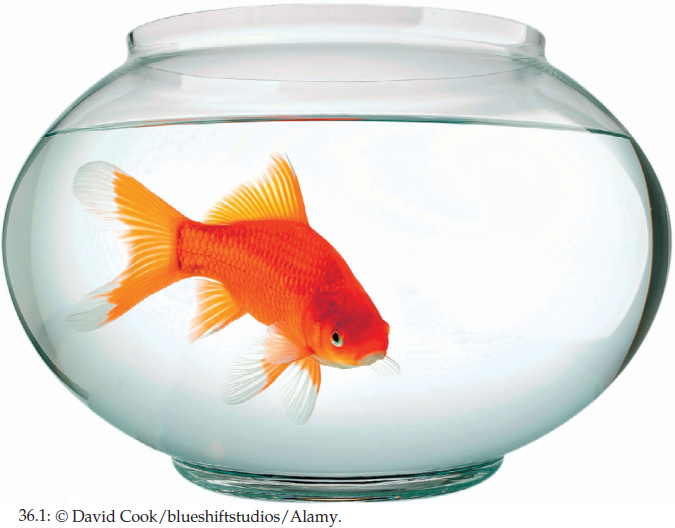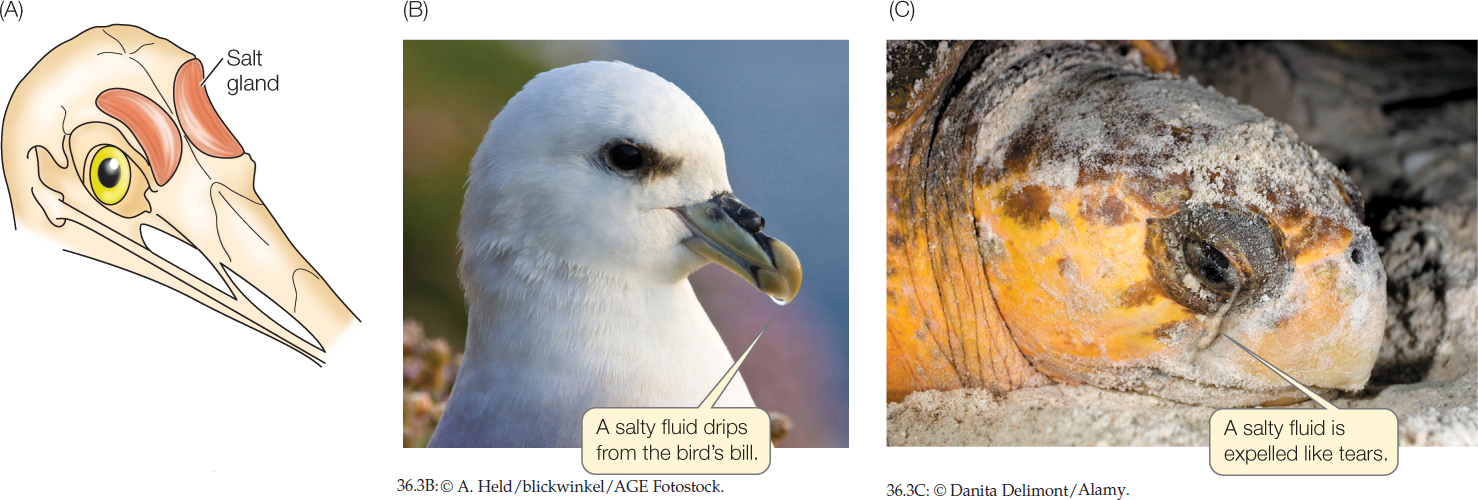CONCEPT36.1 Kidneys Regulate the Composition of the Body Fluids
The body fluids of an animal are crucial for its survival because they provide the context in which all living functions take place. An animal’s cells are bathed by its tissue fluids (intercellular fluids), which make up the environment of the cells: the animal’s internal environment (see Concept 29.3). The organelles inside cells, such as the mitochondria and nucleus, are bathed by the intracellular fluids.
The body fluids have three properties: osmotic pressure, ionic composition, and volume. These properties are interrelated, but often it is helpful to think of them as three distinct characteristics.
- Osmotic pressure. The osmotic pressure is basically a measure of the total concentration of solutes (dissolved matter). Each individual dissolved entity makes an approximately equal contribution to the osmotic pressure. For example, if a body fluid has glucose, Na+, and Cl− dissolved in it, the individual dissolved entities are the individual glucose molecules, Na+ ions, and Cl− ions. Each—regardless of its type—makes a roughly equal contribution to the osmotic pressure. Osmotic pressures are important because they determine the direction of osmotic water movement. Water moves by osmosis from regions where the osmotic pressure (total solute concentration) is low to regions where the osmotic pressure (total solute concentration) is high.A good way to remember this is to recognize that a solution low in solutes is high in water, and vice versa. Water moves by osmosis from where it is high to where it is low: from low osmotic pressure to high osmotic pressure.

- Ionic composition. The principal solutes in most biological solutions are Na+, K+, and Cl−. Other ions, such as Ca2+, also occur. Two solutions of the same osmotic pressure are often very different in ion concentrations. One solution, for example, might be rich in Na+ and the other rich in K+. Thus it is important to consider the concentrations of particular ions, not just the osmotic pressure. Ion concentrations are important for several reasons. One is that they help determine the direction of ion diffusion. Each particular type of ion (such as Na+ or K+) diffuses in response to its particular concentration differences from place to place.
- Volume. We experience the importance of body fluid volume every time we get a bruise that causes tissue swelling. A body fluid may be correct in its osmotic pressure and ion concentrations but may still cause problems if its volume is wrong. Tissue swelling happens because of an accumulation of excess body fluids. Volume is always important even if we don’t notice it. For example, consider a 100-gram goldfish in a goldfish bowl (FIGURE 36.1). The goldfish absorbs so much water from its surroundings by osmosis each day that if the water simply accumulated in its body, the fish would be one-third bigger each morning than it was the morning before. This swelling is prevented because the goldfish regulates its volume and voids the water as fast as it comes in. Large volumes of water are coming and going all the time, nonetheless.

“Water and salt balance” refers to homeostasis of the characteristics of the body fluids: their osmotic pressures, ionic compositions, and volumes. Such homeostasis is important because many of the functions of an animal depend on the characteristics of its body fluids.
LINK
You can review the processes of osmosis and diffusion in Concept 5.2
Kidneys make urine from the blood plasma
The kidneys—sometimes called the renal or excretory organs—of animals are exceptionally diverse, as we will see. In discussing the kidneys, a good starting point is to ask what similarities exist among the kidneys of various types of animals.
All kidneys consist of tubular structures that discharge a fluid directly or indirectly to the outside environment. The fluid that’s excreted into the outside environment is the urine. Sometimes a single kidney consists of a single tubule. This is the case in crayfish and lobsters, for example. In contrast, a kidney may consist of great numbers of tubules. A vertebrate kidney, for example, consists of many microscopically tiny tubules called nephrons. There are about 1 million nephrons in a single human kidney.
753
Each nephron (see Figure 36.11) produces urine. The nephrons discharge into a system of tubes that collects the urine from all of them and discharges it into a single tube, the ureter, that carries the fluid out of the kidney. In mammals, the two ureters carry the urine to the urinary bladder, and from there the fluid is expelled through the urethra during urination (FIGURE 36.2).

Kidneys typically make urine from the blood plasma. Recall that the blood plasma is the blood solution: the part of the blood other than the blood cells (see Concept 29.3).
In essence, a kidney tubule starts with one fluid—the blood plasma—and produces another fluid—the urine. We can analyze kidney function by thinking of the kidney as an input–output organ. How does its output (urine) differ from its input (plasma), and how and why does this transformation take place?
Kidneys regulate the composition and volume of the blood plasma
The most important characteristic of kidneys is that they regulate the composition and volume of the blood plasma. This is their primary function.
The kidneys regulate the composition of the blood plasma by selectively removing materials from the plasma. Think for a moment of a bottle containing a salty solution composed of water, Na+, Cl−, and other ions. Suppose there is a target osmotic pressure for the solution and that its current osmotic pressure is too low. We could raise the osmotic pressure to the target level by removing water from the solution. To be more realistic, however, suppose we can’t remove only water. Suppose that when we remove water, we can’t avoid also removing some ions. In this case, we could raise the osmotic pressure to the target level by unequally, or disproportionately, removing water and ions. If we remove lots of water but only small amounts of ions, the solution’s osmotic pressure will go up. This exemplifies the way that kidneys usually work.
At this point we can define a kidney as an organ composed of tubular structures that produces an aqueous (watery) solution—urine—for excretion. This solution is derived from the blood plasma. The kidney’s primary function is to regulate the composition and volume of the blood plasma by means of controlled removal of solutes and water from the plasma.
Urine/plasma (U/P) ratios are essential tools for understanding kidney function
Suppose the osmotic pressure of an animal’s blood plasma is 100 (we’ll simply use numbers here and not worry about units of measure). Suppose that, at the same time, the animal’s kidneys are excreting urine that has an osmotic pressure of 25. Notice that the urine (25) in this case is more watery (less concentrated with solutes) than the plasma (100).
One way to understand kidney function is to express the composition of the urine as a ratio of the composition of the plasma. Such a ratio is called a urine/plasma, or U/P, ratio. The U/P ratio is 0.25 in the case we’re discussing (25/100 = 0.25). Specifically, this is an osmotic U/P ratio because it’s the ratio of urine and plasma osmotic pressures.
Now recall that the function of making urine is to regulate the plasma. If the osmotic U/P ratio is 0.25, what is the effect on the composition of the plasma? Both the water and the solutes in the urine come from the plasma. We see then that when the kidneys make this watery urine, they take a lot of water out of the plasma but only a little solute. In this way the kidneys modify the composition of the plasma, causing it to become more concentrated. They are raising the osmotic pressure of the plasma.
Suppose, by contrast, that the osmotic U/P ratio is 2.0. In this case the urine is less watery than the plasma. When the kidneys make this urine, they take a lot of solute out of the plasma but only a little water. In this way they cause the plasma to become less concentrated.
These principles are of great importance. An animal’s kidneys typically adjust the U/P ratio up and down to regulate the blood plasma. The principles allow us to interpret the effects of these adjustments:
- If the urine is less concentrated than the plasma (U/P ratio < 1), the kidneys are making the plasma become more concentrated.
- If the urine is more concentrated than the plasma (U/P ratio > 1), the kidneys are making the plasma become more dilute.
These principles can be applied to osmotic pressures (total solute concentrations), as we have done here. They can also be applied to individual ions. For example, if the urine is more concentrated in Na+ than the plasma is, the effect will be to lower the plasma Na+ concentration.
Our day-to-day urine concentrations illustrate these principles
Our urine osmotic pressure is constantly being adjusted up and down by our kidneys to regulate the osmotic pressure of our blood plasma. Human kidneys, at one extreme, can produce urine only one-tenth as concentrated as blood plasma: osmotic U/P = 0.1. At the other extreme, our urine can be four times more concentrated than our plasma: osmotic U/P = 4.0. Our kidneys use this range of variation to perform their regulatory functions.
754
Suppose you drink a great deal of water one day. Your blood plasma might then become too dilute. Sensory structures detect that the plasma osmotic pressure is tending to go down. In response, your kidneys start to make very dilute urine. The osmotic U/P, as we’ve said, could be as low as 0.1. To make this dilute urine, the kidneys unequally remove water and solutes from the plasma: lots of water, little solutes. This process keeps the plasma osmotic pressure from falling.
Suppose that at a different time you go out on a hike and run out of water, so you go 2 days without drinking. Your blood plasma might then become too concentrated. Your kidneys respond to sensory input in this case by making concentrated urine. The osmotic U/P could be as high as 4.0. To make this concentrated urine, the kidneys unequally remove water and solutes from the plasma: lots of solutes, little water. This process keeps the plasma osmotic pressure from rising.
Simultaneously, the kidneys adjust the volume of urine. They do this in ways that help keep plasma volume stable.
To summarize, our kidneys adjust both the composition and the volume of the urine to maintain homeostasis in the composition and volume of the blood plasma. We produce a high volume of dilute urine when we drink lots of water. We produce a low volume of concentrated urine when we are dehydrated. The kidneys, by regulating the composition and volume of the blood plasma in these ways, also regulate the composition and volume of the tissue fluids that bathe the cells of the body.
The range of action of the kidneys varies from one animal group to another
We have seen that the human kidney can adjust the osmotic U/P ratio to be between 0.1 and 4.0. Various types of animals differ in this regard. Why does the range of U/P ratios matter? It matters because the regulatory actions that the kidneys can perform depend on it.
The kidneys of most animals can produce urine that is more dilute than the blood plasma (osmotic U/P < 1). This means that the kidneys of most animals can help with problems of excess water in the body.
Animals vary a lot, however, in how concentrated their urine can be. In the great majority of animal groups, the osmotic U/P ratio cannot be higher than 1.0 because of the ways the kidneys function. Fish, amphibians, lizards, snakes, and turtles cannot produce urine that is more concentrated than their blood plasma. Nor can most aquatic invertebrates. This means that if the blood plasma of these animals is becoming too concentrated, their kidneys cannot correct the problem (only an osmotic U/P ratio higher than 1.0 will cause the plasma osmotic pressure to decrease).
Mammals, birds, and insects stand out because they are the only animals that can produce concentrated urine with an osmotic U/P ratio exceeding 1.0. Mammals have evolved the greatest abilities. Some desert mammals can achieve osmotic U/P ratios as high as 10 or even 20. Some insects can concentrate their urine to an osmotic U/P ratio of 8. Birds are more limited than mammals and insects but can have U/P ratios of 2–3. Notice that all three of these groups of animals live on land. The ability of their kidneys to make concentrated urine is a great asset as these animals try to keep their plasma osmotic pressure normal while facing risks of rapid dehydration in terrestrial environments.
Extrarenal salt excretion sometimes provides abilities the kidneys cannot provide
In some groups of animals, tissues or organs other than the kidneys have evolved the ability to excrete ions at high total concentrations—a process called extrarenal salt excretion (extrarenal, “outside the kidneys”). All the animals with extrarenal salt excretion exhibit two characteristics. First, they live in environments where they either face a high risk of dehydration or tend to gain excess salts during their routine daily lives. Second, they have kidneys that are too limited in their concentrating ability to meet these challenges fully.
Many birds and non-avian reptiles that live in close association with the ocean or in deserts have salt glands. These glands are located in the head and excrete highly concentrated salt solutions. Seabirds and sea turtles, for example, get overloaded with salts from eating marine (ocean) invertebrates, plants, and algae. They depend on their salt glands (FIGURE 36.3) to excrete excess salts. Saltwater fish have specialized salt-excreting cells in their gills, as we will see in Concept 36.3. Mammals—including those living in the oceans—do not have extrarenal salt excretion. Biologists think this is because mammals can depend on their high-performance kidneys to meet all their needs for salt excretion.

755
CHECKpointCONCEPT36.1
- Explain how production of urine with an osmotic U/P ratio of 0.3 helps raise the osmotic pressure of the blood plasma.
- Suppose a person eats lots of salty foods. What effect could this have on the composition of the person’s blood plasma, and how do the kidneys combat it?
- The marine iguanas of the Galápagos Islands are unique among lizards because they principally eat ocean sea-weeds that are as salty as seawater. Periodically a marine iguana “sneezes” a salty solution out of its nostrils. The solution is made by salt glands in the iguana’s head. Why do these animals have salt glands instead of relying entirely on their kidneys for excretion?
We have seen how kidneys regulate the composition and volume of the blood plasma by producing urine of varying osmotic pressure and volume. Next we will discuss the special challenges for excretion posed by proteins and other nitrogen-containing molecules when they are broken down.